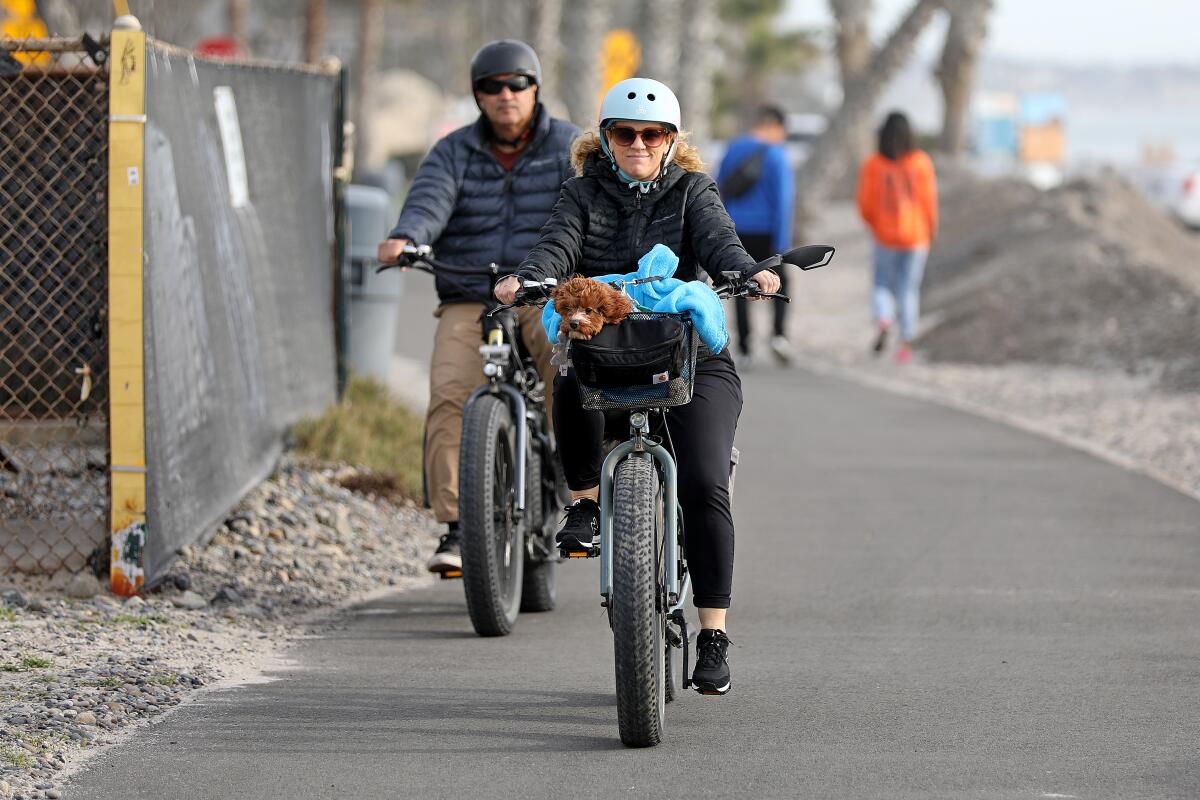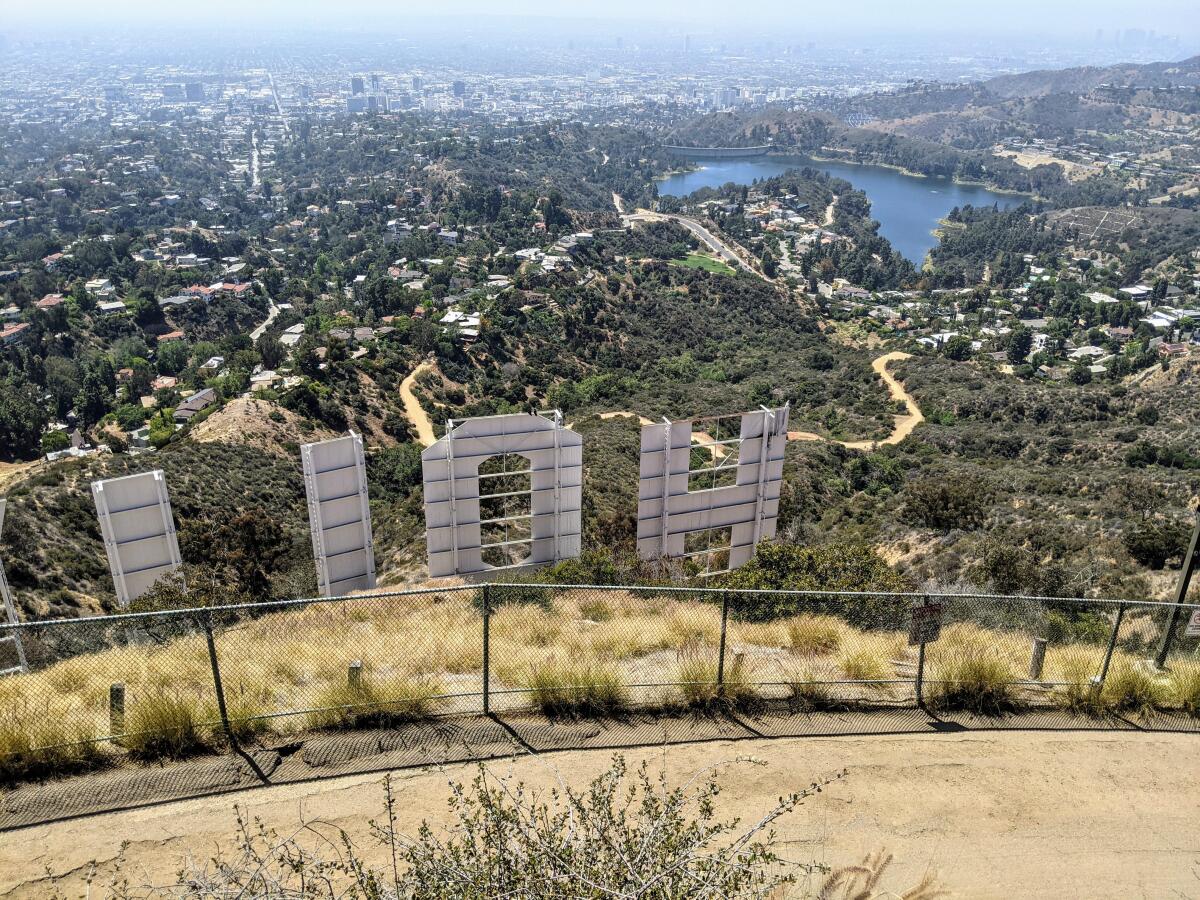There’s a plan to make e-bikes more affordable for low-income Californians. Here’s what to expect

- Share via
Good morning, and welcome to the Essential California newsletter. It’s Tuesday, Feb. 1.
This morning before work, I decided to walk to grab coffee and a light breakfast. I usually make this under-half-a-mile trip once or twice a week, but I’m almost always in my car.
That’s fairly common by U.S. mobility standards. In 2021, more than half of daily vehicle trips in the U.S. (including car, rail, transit and air travel) were less than three miles, according to research compiled for the Bureau of Transportation Statistics. An estimated 28% of vehicle trips were less than one mile.
We know driving less would help reduce toxic vehicle emissions and their effects on air pollution and the climate crisis. That’s easier said than done in a state where we’re driving more in recent years (early pandemic disruptions aside).
There’s one alternative more Americans have been turning to: electric bikes.
E-bike sales have skyrocketed in the past few years. For many, they provide an eco-friendly alternative to driving with comparable travel time and fewer hassles (like finding a parking spot).
And while the cost to purchase and maintain an e-bike is magnitudes lower than what it costs to own a car, not everyone can afford one. A basic e-bike typically retails for somewhere between $1,000 and $2,000 — more if you’re looking to haul kids or other precious cargo without breaking a sweat.
In response to the growing interest in e-bikes, the California Air Resources Board (CARB) is preparing to launch an e-bike incentives program.
“The added benefit with this project is reducing VMT (vehicle miles traveled),” said Lisa Macumber, who leads CARB’s equitable mobility incentives branch. “That’s really going towards the air quality and climate change goals [and] finding ways to help individuals ... get to and from the grocery store, to and from local places, in a way that isn’t putting more cars on the road — and really finding ways to help take cars off the road.”
CARB’s current proposal is to offer a point-of-sale incentive (different from a rebate) of $1,000 off a standard e-bike, with an additional $750 discount for larger cargo bikes, adaptive bikes or recumbent bikes.
The equity-based program will be limited to state residents with household incomes no more than 300% of the federal poverty line. That works out to about $83,000 for a family of four.
There are some additional eligibility requirements and priority criteria, and applications “will be accepted on a first-come first serve basis,” according to a recent presentation from CARB.
The state has allocated the program $13 million in one-time spending. Further funding to continue or expand the program will depend on the state budget, Macumber said.
CARB has hosted seven working groups so far to explain the plan to Californians and hear their thoughts. For Aria Berliner, an air pollution specialist for the agency, the level of public participation has been a standout.
“I’ve been at CARB now for almost four years and I’ve never seen [as] much comment from regular citizens and residents of California... as I have seen in this program,” she said. “That’s really awesome how engaged people are.”
Macumber said participants expressed interest in the increased mobility e-bikes could provide, especially for those who don’t own cars.
“There are opportunities for consumers that typically rely on mass transportation or car sharing programs and things like that,” she said. “This would give them another level of independence.”
The project was initially expected to launch in the first quarter of 2023, but CARB officials told me this week that’s been pushed back to the second quarter.
One challenge CARB faces — along with the future recipients — is safety. With traffic violence surging in recent years, especially among non-car drivers, sharing the road with car drivers could feel daunting.
Many of the lower-income communities that would benefit from the program are also the most dangerous for people to walk or bike. That’s tied to historic neglect, with cities investing less in safety infrastructure (like protected bike lanes) in neighborhoods where more residents rely on walking and transit, while also building major arterial roadways through those communities.
Take Los Angeles, for example, which has an ambitious plan to build out its scattering of bike lanes into a well-connected network. Seven years into that 20-year plan, city leaders acknowledged that only about 3% of the street miles identified for improvements had been upgraded. Safety advocates took action, gathering enough petition signatures to add a local measure to next year’s ballot that will legally compel the city to add bike lanes and other safety upgrades outlined in the plan when it repaves streets.
CARB doesn’t decide how much or how equitably California cities invest in safety upgrades to keep bicyclists safe, but Macumber said the agency can’t wait on cities to step up.
“We really need to get the dollars out there,” she said.
And now, here’s what’s happening across California:
Note: Some of the sites we link to may limit the number of stories you can access without subscribing.
Check out "The Times" podcast for essential news and more
These days, waking up to current events can be, well, daunting. If you’re seeking a more balanced news diet, “The Times” podcast is for you. Gustavo Arellano, along with a diverse set of reporters from the award-winning L.A. Times newsroom, delivers the most interesting stories from the Los Angeles Times every Monday, Wednesday and Friday. Listen and subscribe wherever you get your podcasts.
POLITICS AND GOVERNMENT
State and county officials say thieves are draining cash and food benefits from thousands of low-income families’ electronic benefits cards. Replacing those stolen funds for CalFresh and CalWORKs recipients costs the state tens of millions of dollars each year. One issue: the EBT cards lack security features common in most credit and debit cards. CalMatters
Advertising is nothing new for L.A. County’s regional transit agency, but its latest efforts to put up dozens of large digital billboards across the city of L.A. is drawing criticism. L.A. Metro officials say the ad revenue will help fund bus, rail and other transportation programs. Critics say the signs will distract drivers and create more blight. Los Angeles Times
PUBLIC SAFETY, COURTS AND POLICING
California has issued new voluntary safety guidelines for people who employ domestic workers — such as cleaners, nannies, home care aides and day laborers. Advocates say it’s an important first step to protect millions of workers who lack legal recognition because they work within homes. KQED
A vigil was held at a Sacramento skate park Monday night in memory of Tyre Nichols, the 29-year-old Black man who was brutally beaten by five police officers in Memphis Tenn. last month and died from his injuries a few days later. Nichols grew up in Sacramento and was an avid skateboarder. “This was his favorite place to skate,” Keyana Dixon, Nichols’ sister, told the crowd of more than 100. Sacramento Bee
Alec Baldwin and a movie set armorer have been officially charged with involuntary manslaughter following the 2021 death of cinematographer Halyna Hutchins, who was fatally shot on the set of the Western film. As Patt Morrison writes, it’s the latest in a long history of gun-related injuries and deaths in filmmaking. Los Angeles Times
Support our journalism
HEALTH AND THE ENVIRONMENT

California stands alone in an ongoing negotiation over how Western states will reduce their water rations from the shrinking Colorado River. Arizona, Colorado, Nevada, New Mexico, Utah and Wyoming put forth a joint plan to federal officials, but the Golden State — which uses the single largest share of the river — wasn’t included. Los Angeles Times
Santa Cruz’s beloved promenade isn’t doing so well after getting pummeled by swells from winter storms. Now city leaders there are debating how— or if — they should mend the damaged cliffside path in the face of continued erosion. San Francisco Chronicle
Which L.A. County residents are still most likely to die of COVID-19? Those that haven’t been vaccinated, according to county public health officials. An analysis of data for the bulk of the post-Thanksgiving coronavirus surge showed unvaccinated Angelenos were more than seven times as likely to die from COVID-19 as those who received the the updated bivalent booster. Los Angeles Times
CALIFORNIA CULTURE
20 years after his death, the stars are aligning for Warren Zevon. The singer-songwriter has a lot of famous fans — many of whom are now lobbying to have him nominated to the Rock & Roll Hall of Fame. That includes Billy Joel, who said Zevon “exemplified the soul of L.A. — if there is one.” Los Angeles Times
Free online games
Get our free daily crossword puzzle, sudoku, word search and arcade games in our new game center at latimes.com/games.
AND FINALLY
Today’s landmark love comes from Mario Obejas of Torrance: the famed Hollywood Sign, or more specifically, the view behind it from Mt. Lee.

Mario writes:
What makes [the sign] special is the associated inspiration to work toward your dreams against the odds. The sign is instantly recognizable by just about anyone in the world. In greater L.A. we can see it from many vantage points and there’s a zillion shots of the front. But how many people go up there and get the beautiful vista behind it? I lead group bike rides frequently and this is my favorite one to lead, to share the vista. It’s a very steep walk or ride, but the reward is worth it.
What are California’s essential landmarks? Fill out this form to send us your photos of a special spot in California — natural or human-made. Tell us why it’s interesting and what makes it a symbol of life in the Golden State. Please be sure to include only photos taken directly by you. Your submission could be featured in a future edition of the newsletter.
Please let us know what we can do to make this newsletter more useful to you. Send comments to [email protected].
Sign up for Essential California
The most important California stories and recommendations in your inbox every morning.
You may occasionally receive promotional content from the Los Angeles Times.




